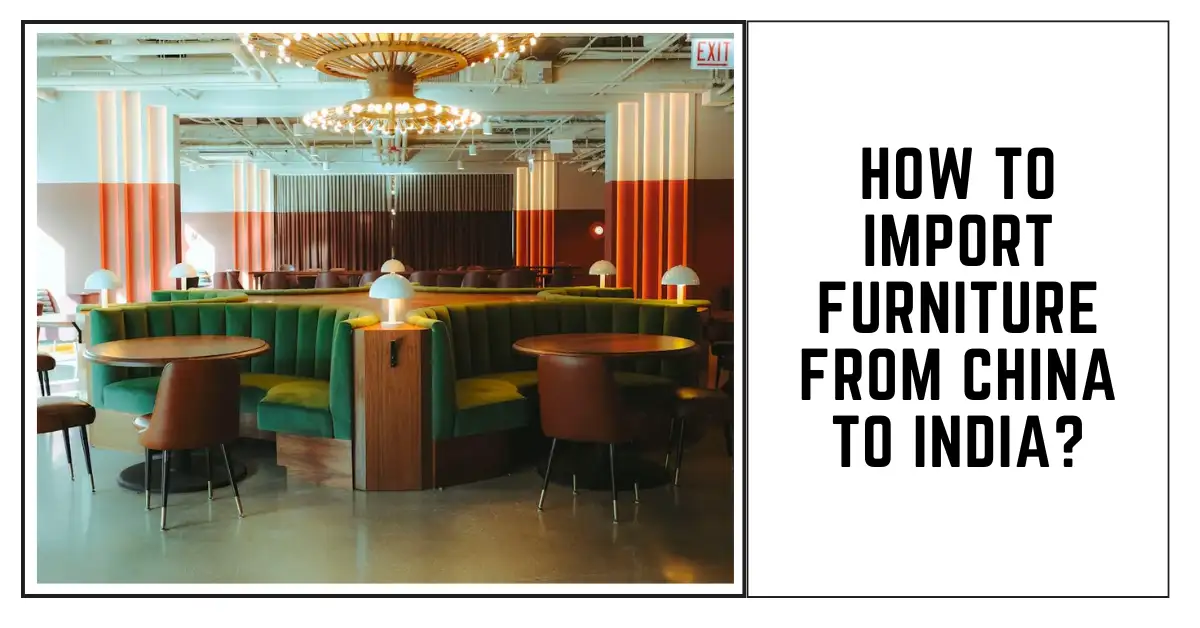How to Import Furniture From China to India?

How to Import Furniture From China to India?
China dominates much of the global furniture export scene, offering mass-produced lines, custom capabilities, and competitive pricing. If you’re in India and eyeing Chinese furniture for a retail store, a home project, or a large commercial endeavor, how do you proceed?
Steps to Import Furniture From China to India
Below, we outline steps, from researching suppliers to handling customs.
Step 1: Clarify Your Needs
- Are you importing for personal use, or do you plan to stock a furniture store?
- Do you crave high-volume budget items, or niche custom designs?
- Chinese factories can cater to both ends.
- Identify item types (sofas, dining sets, office furniture) and approximate volumes.
- A clear plan helps you filter potential suppliers quickly.
VISIT FOR :: Commercial bar design
Step 2: Research
- Check trade platforms like Alibaba, Made-in-China, or attend local fairs like the Canton Fair (if possible).
- Alternatively, if you want a unique industrial twist, Suren Space (though based in India) could complement your Chinese items.
- Assess each supplier’s reliability, look at reviews, certifications, or references.
- Be mindful of whether they have export experience to India; prior knowledge simplifies formalities.
Step 3: Verification
- Once you spot potential manufacturers, request catalogs or samples.
- Quality can range from basic to premium, as Chinese makers serve diverse markets.
- Check material specs, finishes, joinery methods, or weight-bearing capacity.
- If you’re ordering large quantities, hiring a QC agent in China might reduce risk.
- Seeing or testing sample pieces ensures you avoid subpar shipments.
Step 4: Cost Discussions
- Chinese furniture is often priced attractively, but bargains vary by volume, design complexity, or brand prestige.
- Discuss incoterms: FOB (Free On Board) at a Chinese port or CIF (Cost, Insurance, Freight) to an Indian port.
- A partial deposit is common, with the balance upon shipping or after final inspection.
- If you’re placing a big commercial order, a letter of credit can safeguard both parties.
Step 5: Freight Setup
- Sea freight from major Chinese ports (e.g., Shenzhen, Shanghai, Ningbo) to Indian ports (like Mumbai, Chennai) is typical.
- A freight forwarder helps secure container space, handle customs, and arrange local transport in India.
- Large orders might fill a 20ft or 40ft container, which is cheaper per unit.
- Smaller orders can go LCL (Less than Container Load), though rates per cubic meter can be higher.
- Confirm packaging standards: wooden crates, foam wrap, or corrugated boxes, to protect items during transit.
Step 6: Indian Import Regulations
- India imposes import duties on wooden or metal furniture, with rates varying by product classification.
- Check HS codes (Harmonized System codes) to identify the correct duty bracket.
- Your forwarder or customs broker can help.
- Documents typically include a commercial invoice, packing list, Bill of Lading, and any product certificates.
- For wooden furniture, check if your items need fumigation or a phytosanitary certificate to clear Indian port regulations.
VISIT FOR :: cool podcast studio
Step 7: Scheduling
- Chinese factories might take weeks or months for large or custom orders.
- Add sea transit time (usually 2–6 weeks) plus port clearance.
- If you have a store launch or project deadline, plan at least a couple of months in advance.
- Rushing production can incur extra fees or risk quality dips.
- Stay updated on potential holiday shutdowns, like Chinese New Year.
Step 8: Final Checks
- Request photos or videos before items are packed.
- If your order is big, consider a pre-shipment inspection by a third-party QC agent.
- They confirm color, dimensions, or finishing.
- Catching errors before loading the container saves major headaches.
- Document your requirements in a contract, referencing the exact color codes, materials, or design sketches.
Step 9: Arrival
- Once cargo reaches an Indian port, your customs broker or clearing agent files the Bill of Entry, pays import duties, and obtains release.
- Then, local transport (truck or rail) delivers to your warehouse or store.
- Check the items for damage or shortages promptly, and document and notify suppliers or insurers if issues arise.
Potential Challenges and Solutions
- Language Gaps: Some Chinese suppliers may require careful communication. Use interpreters or rely on B2B platforms with English-speaking reps.
- Holiday Delays: Chinese New Year halts factories for up to two weeks. Plan around it.
- Quality Variation: Thorough sampling and referencing brand reputation helps.
- Logistics Delays: Port congestion or container shortages happen, so keep a buffer timeline.
Final Budget Calculation
- Item cost + shipping + import duty + local taxes + potential warehousing = total landed cost.
- For store resellers, confirm if your margin remains profitable after these expenses.
- For personal use, decide if the unique design or cost advantage is worth the complexities.
- Sometimes local Indian brands might match or beat the price once shipping is factored unless you’re seeking a style only found in China.
Conclusion
Importing furniture from China to India can open avenues of design variety and competitive pricing. Still, a methodical process, supplier vetting, freight planning, and customs compliance minimize risks. Suren Space or other domestic brands might complement your Chinese imports if you want a broader array of products. A structured approach ensures your items arrive safely, on time, and align with quality expectations, ready to enhance homes or retail spaces in India.
READ MORE :: Top 10 Restaurant Furniture Brands in Orlando, Florida

